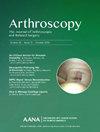脊柱病变可能改善或恶化髋关节镜手术后的疗效:患者评估和适应症至关重要。
IF 4.4
1区 医学
Q1 ORTHOPEDICS
Arthroscopy-The Journal of Arthroscopic and Related Surgery
Pub Date : 2025-02-01
DOI:10.1016/j.arthro.2024.09.046
引用次数: 0
摘要
与全髋关节置换术相比,髋关节镜手术是一种相对较新的手术,因此,青壮年的髋脊柱综合征是一个新兴的研究课题。在过去的十年中,我们对脊柱骨盆对位的了解提高了髋关节置换术的稳定性,也延长了腰椎融合患者的生存期。显然,髋关节影响脊柱,脊柱影响髋关节。就髋关节镜而言,就像老年患者和软骨损伤患者的治疗效果较差一样,脊柱病变患者术后也有脊柱症状恶化的风险,包括坐骨神经痛。此外,背痛和根性疼痛可能会限制髋关节术后康复。然而,也有一些患者在髋关节镜术后背部症状得到缓解。如今,建议进行髋关节镜手术的外科医生必须首先调查患者的矢状平衡,包括骨盆倾斜、骨盆入射角和骶骨斜度。与孤立的FAIS患者相比,在适当的情况下,髋关节疼痛患者的病情改善率更高,失败风险也不会增加。例外情况包括合并腰椎管狭窄或腰椎融合术的患者。如果患者之前进行过1-2个级别的融合术,那么髋关节镜复查率和转为全髋关节置换术的比率是对照组的两倍,如果进行过3个或更多级别的融合术,则是对照组的三倍。我们对髋关节-脊柱患者关节镜检查结果的了解仍在不断深入。除了全面的脊柱检查外,还必须调查患者的脊柱手术史和当前的脊柱症状,以确定髋关节镜的疗效。如果患者同时伴有髋关节和脊柱症状,则必须进行髋关节注射诊断,以确定疼痛的主要来源。如果髋关节是疼痛的根源,则应告知患者髋关节镜手术后背部症状可能会改善,但并非所有病例都会如此。测量矢状面平衡的 EOS 成像可以让外科医生预测,在脊柱僵硬的情况下,髋关节 X 光片上的撞击测量值是否会被低估。如果患者存在多种不良后果的风险因素,如年龄增长、关节软骨损伤、边缘发育不良、活动度过大,再加上多级腰椎融合术史或脊柱畸形,那么髋关节镜手术可能并不理想,应考虑髋关节置换术。显然,FAIS 患者的脊柱不容忽视。本文章由计算机程序翻译,如有差异,请以英文原文为准。
Editorial Commentary: Spine Pathology May Improve or Worsen Outcomes After Hip Arthroscopy: Patient Evaluation and Indications Are Critical
Compared with total hip arthroplasty, hip arthroscopy is a relatively new procedure, and as such, hip-spine syndrome in young adults is an emerging topic of research. In the past decade, our understanding of spinopelvic alignment has improved the stability and survivorship of hip replacements in patients with prior lumbar fusions. Obviously, the hip affects the spine and the spine affects the hip. In terms of hip arthroscopy, just as older patients and patients with cartilage damage have inferior outcomes, patients with spine pathology are at risk for postoperative worsening spinal symptoms, including sciatica. In addition, back and radicular pain may limit postoperative hip rehabilitation. Yet other patients show resolution of back symptoms after hip arthroscopy. Today, surgeons indicating hip arthroscopy must first investigate patient sagittal balance, which includes pelvis tilt, pelvic incidence, and sacral slope. When properly indicated, hip-spine pain patients show greater percentage improvement with no increased failure risk compared with patients with isolated FAIS. Exceptions include patients with concomitant lumbar stenosis or lumbar fusion. Rate of revision hip arthroscopy and conversion to total hip replacement is 2-fold compared with controls if patients had prior 1-2 level fusion and 3-fold if 3 or more levels are fused. Our understanding of hip-spine patients with regard to arthroscopy outcomes continues to develop. In addition to a comprehensive spine exam, the patient’s spine surgical history and current spine symptoms must be investigated to predict the efficacy of hip arthroscopy. If patients have both hip and spine symptoms, a diagnostic hip injection to determine the prime pain generator is essential. If the hip is the source of pain, patients should be counseled that back symptoms will likely improve after hip arthroscopy but not in all cases. EOS imaging to measure sagittal balance may allow the surgeon to predict if impingement measurements on hip radiographs may be underestimated in the setting of a stiff spine. If the patient has multiple risk factors for poor outcomes such as advancing age, articular cartilage damage, borderline dysplasia, or hypermobility, on top of a history of multilevel lumbar fusion or spinal deformity, hip arthroscopy may not be ideal, and hip arthroplasty should be considered. Clearly, the spine may not be ignored in patients with femoroacetabular impingement.
求助全文
通过发布文献求助,成功后即可免费获取论文全文。
去求助
来源期刊
CiteScore
9.30
自引率
17.00%
发文量
555
审稿时长
58 days
期刊介绍:
Nowhere is minimally invasive surgery explained better than in Arthroscopy, the leading peer-reviewed journal in the field. Every issue enables you to put into perspective the usefulness of the various emerging arthroscopic techniques. The advantages and disadvantages of these methods -- along with their applications in various situations -- are discussed in relation to their efficiency, efficacy and cost benefit. As a special incentive, paid subscribers also receive access to the journal expanded website.

 求助内容:
求助内容: 应助结果提醒方式:
应助结果提醒方式:


